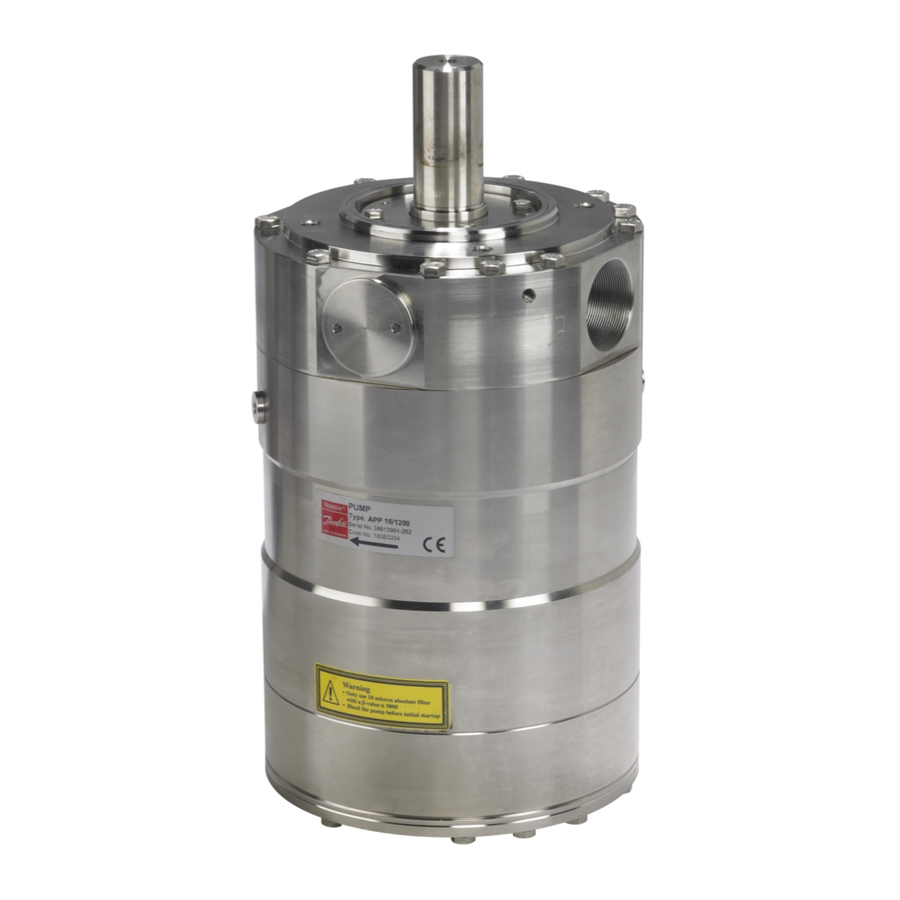Danfoss APP series Інструкція - Сторінка 7
Переглянути онлайн або завантажити pdf Інструкція для Водяний насос Danfoss APP series. Danfoss APP series 10 сторінок. Disassembling and assembling
Також для Danfoss APP series: Посібник з експлуатації (12 сторінок), Посібник з експлуатації (12 сторінок), Інструкція з розбирання та збирання (12 сторінок)

Instruction
4.
Initial start-up
5.
Operation
zu entfernen. Jedoch sollte das System vor der ersten Inbetriebnahme
Jedoch sollte das System vor der ersten Inbetriebnahme
– ohne die angeschlossene Pumpe - durchgespült werden.
– ohne die angeschlossene Pumpe - durchgespült werden.
Warnung:
Beachten Sie, daß die Drehrichtung vom Elektromotor mit der Dreh-
richtung der Pumpe übereinstimmt, da anderenfalls die Pumpe zerstört
wird.
APP pump instruction APP (W) 5.1-10.2
Bitte bemerken Sie: Die Pumpen werden mit Frostschutzmittel Dowcal N
konserviert.
Before start-up, loosen the top bleeding plug "C".
When water appears from the bleeding plug,
retighten the plug. With its inlet line connected
to the water supply or the tank, the pump is now
started with open outlet port.
At the initial start of the system, the pump
should be run without pressure for about
5 minutes, thus removing possible impurities
from pipes, hoses, etc. However, the system
should be flushed before start-up – without the
connected pump.
WARNING
Make sure that the direction of rotation of the
electric motor corresponds to the direction of
rotation of the pump. Otherwise the pump will
be damaged if a check valve is placed between
pump and tank.
5.1 Temperature
Fluid temperature:
Min. +2° C to max. +50° C
(Min. +35.6° F to max. +122° F)
Ambient temperature:
Min. +2° C to max. +50° C
(Min. +35.6° F to max. +122° F)
In case of lower operating temperatures, please
contact the Danfoss High Pressure Pumps.
521B0747 DKCFN.PI.010.D3.ML
5.2 Pressure
The inlet pressure must be min. 0.5 barg
(7.25 psig) and max. 5 barg(72.5 psig). At lower
pressures the pump will cavitate, resulting in
damage of the pump.
Max. pressure on the pump's outlet line should
be limited at 80 barg (1160 psig) continuously.
Short-term pressure peaks (e.g. in connection
with closing of a valve) of up to 100 barg
(1450 psig) are acceptable.
Note: The pump unit should include a pressure
gauge on the high-pressure side.
5.3 Dry running
When running, the pump must always be
connected to the water supply in order to avoid
damage if it should run dry.
In systems with water tank it is recommended to
build in a level gauge in the tank to avoid the risk
of running dry.
5.4 Disconnection
If the inlet line is disconnected from the water
supply, the pump will be emptied of water
through the disconnected inlet line.
180R9072 / 521B0747 / DKCFN.PI.010.D5.02 / 11.2014
rezas que pueda haber en las tubería
sistema deberá de ser enjuagado (fl u
sistema deberá de ser enjuagado (fl u
conectar la bomba.
Advertencia:
Asegúrese de que la dirección de la r
ponda a la dirección de la rotación de
dañarse si se coloca una válvula antir
Nota: Las bombas se almacenan con
When starting up again, follow the bleeding
procedure described under section 4: Initial start
up.
5.5 Storage
Storage temperature:
Min. -40° C to max. +70° C
(Min. -40° F to max. +158° F)
When preparing the pump for long-term storage
or for temperatures below the freezing point,
flush the pump with an anti-freeze medium type
monopropylene glycol to prevent internal
corrosion or frost in the pump.
For further information on anti-freeze media,
please contact the Danfoss High Pressure Pumps.
Recommended procedure:
5.5.1 Open-ended systems with water supply
from tank
1.
Empty the tank of water and empty the
pump housing through the lower bleeding
plug. When the pump is empty, retighten
the plug.
2.
Through the upper bleeding plug, fill the
pump housing with anti-freeze medium.
Pour anti-freeze medium into the tank.
Connect a hose to the outlet of the pump
and lead the other end of the hose back to
tank.
3.
Quickly start and stop the pump. Make
sure that the pump does not run dry. The
pump is now protected against internal
corrosion and frost.
7
